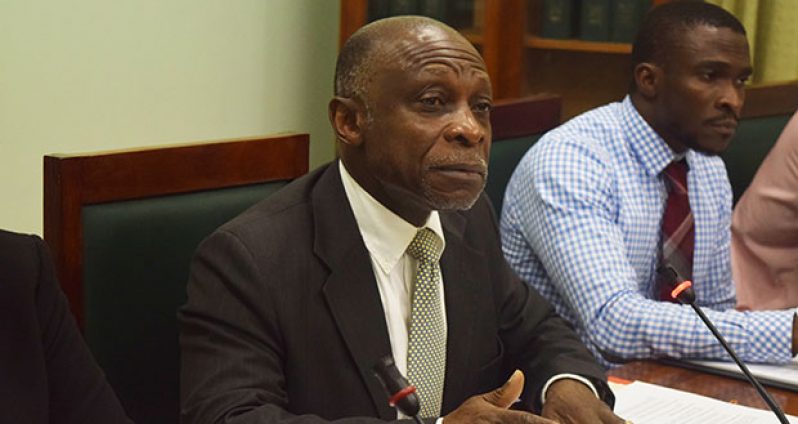By Derwayne Wills
THROUGH an almost 15-year-old agreement with Brazil, Guyana purchased GYD$26.7B in products from the Portuguese industrialised nation from 2011 to June 2016, but sold only GYD$3.2B in products to that country for the same period. Foreign Minister Carl Greenidge presented himself before the National Assembly’s sectoral committee on Foreign Relations, where he updated the committee, chaired by Opposition Chief Whip Gail Teixeira on the status of the trade agreement between Guyana and its Portuguese-speaking neighbour.

Greenidge’s presentation focused on the notable imbalance between Guyana imports from and exports to Brazil, which show a difference of GYD$23.5B for the period 2011 to June 2016. As a means of closing this trade gap, Greenidge championed the need for increased trade promotion by his ministry as well as this country’s private sector. He similarly called for larger scale operations and greater collaboration between his ministry and the private sector.
The foreign minister explained that the agreement, which facilitates involvement with Guyana’s private sector, allows for a relaxation of taxes on particular products moving between the two countries, so that those specially selected products can flow easily. Products moving between the countries are classified in broad categories called “tariff lines,” Greenidge expounded. Products can be lumped under categories, called ‘tariff lines,’ as manufactured, agricultural products etc.
This agreement gives Guyana an advantage over its immediate neighbours who also compete for space on the Brazilian market.
As part of a quota system, which means Brazil will allow a specified quantity of products from Guyana and from other countries so as to ensure countries are given fair access to Brazil’s market, Guyana exports 10,000 tonnes of sugar; 10,000 tonnes of rice; and 100 tonnes of red peppers.
Greenidge said other than sugar, rice, and peppers, there are other agricultural products which can be exported to Brazil under the agreement, but the list of products must be drafted with inputs from Guyana’s Agriculture Ministry as well as from the private sector.
Speaking directly to why there is an imbalance of imports to exports, Greenidge explained that Brazil has some 830 tariff lines coming into Guyana, while Guyana has some 127 tariff lines going to Brazil.
“It is a reflection of our relative capacities,” Greenidge said in his defence. “Guyana has a relatively limited range of products that it can export.” The foreign minister sees this not only as a feature of underdevelopment, but also a feature of “limited capacity of our exporters.”
While Guyana exports 10,000 tonnes of rice to Brazil, there were questions from the committee as to whether more rice could not be exported to that country, since the collapse of Venezuela’s agreement in 2015 to purchase Guyana’s rice in exchange for fossil fuels.
Foreign relations committee members Zulficar Mustapha questioned the possibility of negotiating for Brazil to absorb Guyana’s rice which went to Venezuela up to 2015.
Mustapha implored Greenidge to engage the administrative commission, a body made up of Guyanese and Brazilian officials, to expand Guyana’s quota of rice to Brazil from 10,000 tonnes.
In his response, Greenidge noted part of the reason for the 10,000-tonne quota has to do with the close proximity of Santa Fe in Region Nine (Upper Takutu-Upper Essequibo) to the Brazilian border.
Rice coming from Guyana’s coast, on the other hand, would not be feasible considering the logistics of such an arrangement, but Greenidge said he will bear it in mind.
Another challenge facing the movement of coastal goods from Guyana’s coast to the interior regions and closer to Brazil’s border is the condition of the Linden to Lethem Road. This concern was raised yesterday by Foreign Relations committee member, Nigel Dharamlall.
Greenidge said Guyana had met with Brazilian officials, including President Dilma Roussef, some time ago, and that there was an agreement by both sides to have a feasibility study done on the road.
Similarly, there were hopes that the study would be funded through the Chinese-Latin America agreement, but because of the current political situation in Brazil, where that country’s President is facing an impeachment trial, Greenidge said this is difficult.
“Until such time as Brazil settles down at the political level, you are not likely to see such progress in that regard,” Greenidge continued.
This situation also sees the proposed deep-water harbour in Guyana being placed in limbo, even as Brazil could benefit substantially from its construction.
“The difference between exporting via the eastern ports [of Brazil] and coming through Guyana to the north is five or more days,” Greenidge told the committee.



.jpg)









